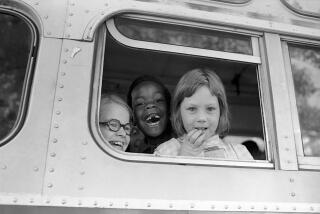Separate Is Seldom Equal
- Share via
In troubled Bosnia, there is an echo audible to Americans in the composition of school classes. Here in the United States it was the color of their skins that divided students into separate schools until the Supreme Court’s hallmark 1954 decision in Brown vs. Board of Education. In Bosnia today, it is ethnicity that classifies pupils: the Croats, the Serbs and the Muslims. Divided by rulers who have made nationalism an exclusion clause, young Bosnians are paying the price of their parents’ hatreds.
In a discouraging on-scene report from Times correspondent Tracy Wilkinson, the sorrowful impact of nationalism in the schoolhouse reflects in a small way the problems facing the effort to make Bosnia a workable multiethnic state.
The western half of Bosnia comprises the Muslim and Croat communities, and when school doors opened this fall one of the first lessons was division. By a show of hands or letters to parents, it was quickly established who was Muslim and who was Croat, and off to separate classrooms they went. The Roman Catholic Croats and the Muslims follow roughly the same curriculum in many subjects, but not when it comes to history. Education officials call the system “separate but equal.” Ring a bell?
Bosnian Croat students take the same courses taught to their cousins in the mother country, adjacent Croatia, including the assertion that their capital is Zagreb, the Croatian capital, not Sarajevo, the Bosnian capital. Bosnian Muslims study Islam. Schools for Serbs, the third ethnic faction in Bosnia-Herzegovina, are administered by the Republika Srpska regime.
Bosnia has a chance to become a viable state again. Commendably, Western nations are pouring in aid and trying to build the foundations. But a state whose No. 1 classroom subject is ethnic nationalism needs a new curriculum.
More to Read
Sign up for Essential California
The most important California stories and recommendations in your inbox every morning.
You may occasionally receive promotional content from the Los Angeles Times.













